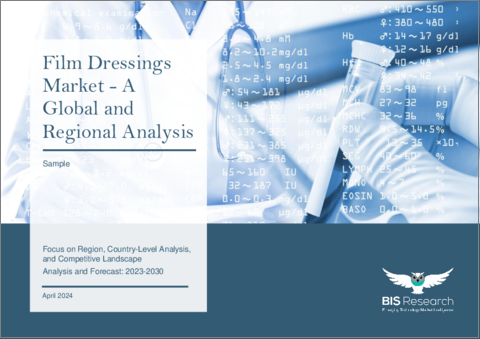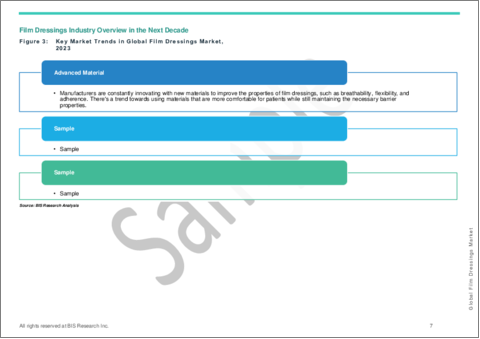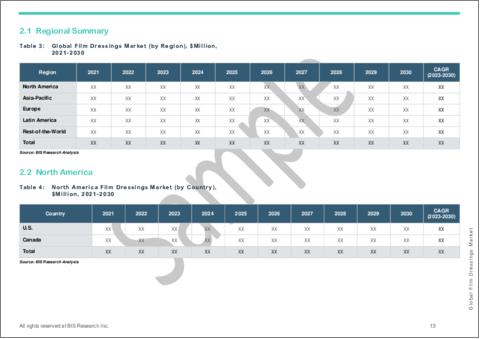|
|
市場調査レポート
商品コード
1464573
フィルムドレッシング市場- 世界および地域別分析:地域別、国別分析、競合情勢:分析と予測(2023年~2030年)Film Dressings Market - A Global and Regional Analysis: Focus on Region, Country-Level Analysis, and Competitive Landscape - Analysis and Forecast, 2023-2030 |
||||||
カスタマイズ可能
|
|||||||
| フィルムドレッシング市場- 世界および地域別分析:地域別、国別分析、競合情勢:分析と予測(2023年~2030年) |
|
出版日: 2024年04月19日
発行: BIS Research
ページ情報: 英文 43 Pages
納期: 1~5営業日
|
全表示
- 概要
- 図表
- 目次
フィルムドレッシングの市場規模は、2022年に5億650万米ドルとなりました。
同市場は、2023年から2030年にかけて4.08%のCAGRで拡大し、2030年には6億9,590万米ドルに達すると予測されています。この市場は、すると予想されています。このような成長の背景には、効果的な保護を提供し、治癒を促進し、患者の快適性を高める高度な創傷ケアソリューションに対する需要の増加があります。
| 主要市場統計 | |
|---|---|
| 予測期間 | 2023年~2030年 |
| 2023年の評価額 | 5億2,590万米ドル |
| 2030年予測 | 6億9,590万米ドル |
| CAGR | 4.08% |
半透性、薄型、粘着性という特徴を持つフィルムドレッシングは、軽度の切り傷や擦り傷から慢性の潰瘍や外科的切開まで、さまざまな創傷を管理するために臨床と在宅ケアの両方の現場で特に好まれています。複雑な創傷を引き起こす糖尿病などの慢性疾患の増加と、フィルムドレッシング材の機能性と有効性を向上させる材料科学の進歩は、市場を前進させる重要な要因です。さらに、患者中心の医療へのシフトや、自宅での効果的な創傷管理による入院期間の短縮が重視されるようになっていることも、世界のフィルムドレッシング材の採用拡大に寄与しています。
当レポートでは、世界のフィルムドレッシング市場について調査し、市場の概要とともに、国別、地域別の動向、および市場に参入する企業のプロファイルなどを提供しています。
目次
エグゼクティブサマリー
第1章 市場
- 製品定義
- 包含基準と除外基準
- 主な質問への回答
- 分析と予測ノート
- 主な調査結果
第2章 地域
- 地域別概要
- 北米
- 米国
- カナダ
- 欧州
- ドイツ
- オーストリア
- チェコ共和国
- ギリシャ
- ポーランド
- ルーマニア
- ロシア連邦
- スロバキア
- トルコ
- ウクライナ
- ベルギー
- デンマーク
- フィンランド
- フランス
- アイルランド
- イタリア
- オランダ
- ノルウェー
- ポルトガル
- スペイン
- スウェーデン
- スイス
- 英国
- アジア太平洋
- オーストラリア
- 中国
- インド
- 日本
- マレーシア
- 韓国
- タイ
- ラテンアメリカ
- アルゼンチン
- ブラジル
- チリ
- コロンビア
- メキシコ
- その他の地域
第3章 市場-競合ベンチマーキング
- 主な戦略と開発
- 主要企業エコシステム
第4章 調査手法
List of Figures
- Figure 1: Global Film Dressings Market, $Million, 2022, 2025, and 2030
- Figure 2: Global Film Dressings Market (by Region), $Million, 2022, 2025, and 2033
- Figure 3: Key Market Trends in Global Film Dressings Market, 2023
- Figure 4: U.S. Film Dressings Market, $Million, 2021-2030
- Figure 5: Canada Film Dressings Market, $Million, 2021-2030
- Figure 6: Germany Film Dressings Market, $Million, 2021-2030
- Figure 7: Austria Film Dressings Market, $Million, 2021-2030
- Figure 8: Czech Republic Film Dressings Market, $Million, 2021-2030
- Figure 9: Greece Film Dressings Market, $Million, 2021-2030
- Figure 10: Poland Film Dressings Market, $Million, 2021-2030
- Figure 11: Romania Film Dressings Market, $Million, 2021-2030
- Figure 12: Russian Federation Film Dressings Market, $Million, 2021-2030
- Figure 13: Slovakia Film Dressings Market, $Million, 2021-2030
- Figure 14: Turkey Film Dressings Market, $Million, 2021-2030
- Figure 15: Ukraine Film Dressings Market, $Million, 2021-2030
- Figure 16: Belgium Film Dressings Market, $Million, 2021-2030
- Figure 17: Denmark Film Dressings Market, $Million, 2021-2030
- Figure 18: Finland Film Dressings Market, $Million, 2021-2030
- Figure 19: France Film Dressings Market, $Million, 2021-2030
- Figure 20: Ireland Film Dressings Market, $Million, 2021-2030
- Figure 21: Italy Film Dressings Market, $Million, 2021-2030
- Figure 22: Netherlands Film Dressings Market, $Million, 2021-2030
- Figure 23: Norway Film Dressings Market, $Million, 2021-2030
- Figure 24: Portugal Film Dressings Market, $Million, 2021-2030
- Figure 25: Spain Film Dressings Market, $Million, 2021-2030
- Figure 26: Sweden Film Dressings Market, $Million, 2021-2030
- Figure 27: Switzerland Film Dressings Market, $Million, 2021-2030
- Figure 28: U.K. Film Dressings Market, $Million, 2021-2030
- Figure 29: Australia Film Dressings Market, $Million, 2021-2030
- Figure 30: China Film Dressings Market, $Million, 2021-2030
- Figure 31: India Film Dressings Market, $Million, 2021-2030
- Figure 32: Japan Film Dressings Market, $Million, 2021-2030
- Figure 33: Malaysia Film Dressings Market, $Million, 2021-2030
- Figure 34: South Korea Film Dressings Market, $Million, 2021-2030
- Figure 35: Thailand Film Dressings Market, $Million, 2021-2030
- Figure 36: Argentina Film Dressings Market, $Million, 2021-2030
- Figure 37: Brazil Film Dressings Market, $Million, 2021-2030
- Figure 38: Chile Film Dressings Market, $Million, 2021-2030
- Figure 39: Colombia Film Dressings Market, $Million, 2021-2030
- Figure 40: Mexico Film Dressings Market, $Million, 2021-2030
- Figure 41: Data Triangulation
- Figure 42: Top-Down and Bottom-Up Approach
- Figure 43: Assumptions and Limitations
List of Tables
- Table 1: Market Snapshot
- Table 2: Global Film Dressings Market, Opportunities
- Table 3: Global Film Dressings Market (by Region), $Million, 2021-2030
- Table 4: North America Film Dressings Market (by Country), $Million, 2021-2030
- Table 5: Europe Film Dressings Market (by Country), $Million, 2021-2030
- Table 6: Asia-Pacific Film Dressings Market (by Country), $Million, 2021-2030
- Table 7: Latin America Film Dressings Market (by Country), $Million, 2021-2030
- Table 8: Rest-of-the-World Film Dressings Market (by Country), $Million, 2021-2030
- Table 9: Key Initiatives, 2021-2024
- Table 10: Key Companies in the Global Film Dressings Market
Global Film Dressings Market Industry Overview
The global film dressings market, valued at $506.5 million in 2022, is on a trajectory of robust growth and is anticipated to reach $695.9 million by 2030. This market is expected to expand at a compound annual growth rate (CAGR) of 4.08% between 2023 and 2030. Such growth is fueled by an increasing demand for advanced wound care solutions that offer effective protection, promote healing, and enhance patient comfort.
Market Introduction
| KEY MARKET STATISTICS | |
|---|---|
| Forecast Period | 2023 - 2030 |
| 2023 Evaluation | $525.9 Million |
| 2030 Forecast | $695.9 Million |
| CAGR | 4.08% |
Film Dressings, known for their semi-permeable, thin, and adhesive characteristics, are especially favored in both clinical and home care settings for managing a variety of wounds, from minor cuts and abrasions to chronic ulcers and surgical incisions. The rise in chronic conditions such as diabetes, which can lead to complex wounds, along with advancements in material science that improve the functionality and efficacy of film dressings, are significant factors driving the market forward. Additionally, the shift toward patient-centered care and the growing emphasis on reducing hospital stays through effective wound management at home are contributing to the increased adoption of film dressings worldwide.
Regional Segmentation:
- North America
- U.S.
- Canada
- Europe
- U.K.
- Germany
- France
- Italy
- Spain
- Netherlands
- Switzerland
- Russian Federation
- Turkey
- Poland
- Belgium
- Sweden
- Ireland
- Norway
- Austria
- Denmark
- Finland
- Portugal
- Czech Republic
- Romania
- Greece
- Slovakia
- Ukraine
- Asia-Pacific
- Japan
- China
- India
- South Korea
- Australia
- Malaysia
Thailand
- Latin America
- Brazil
- Mexico
- Colombia
- Argentina
- Chile
- Rest-of-the-World
The global film dressings market is witnessing varied growth rates across different regions, with a total market valuation rising from $506.5 million in 2022 to an anticipated $695.9 million by 2030, achieving a CAGR of 4.08%. North America leads in terms of market size, growing from $188.4 million in 2022 to a projected $244.0 million by 2030 at a CAGR of 3.32%, reflecting the region's advanced healthcare infrastructure and high adoption rates of innovative wound care solutions. Rest-of-the-World, however, showcases the highest growth rate at a 5.60% CAGR, attributed to increasing awareness of advanced wound management. Europe presents a steady growth at a 2.96% CAGR, underpinned by its well-established healthcare systems and focus on quality wound care. Latin America and the Asia-Pacific regions are not far behind, with CAGRs of 4.79% and 5.04%, respectively, driven by improvements in healthcare infrastructure and expanding access to modern medical technologies. This regional analysis underscores the global demand for film dressings, fueled by a growing need for effective wound care across diverse healthcare landscapes.
Recent Developments in the Film Dressings Market
- In May 2022, The Technical University of Munich (TUM) researchers engineered a film that not only would provide wound protection akin to a bandage but would also accelerate wound healing. This innovative film repels bacteria, mitigates inflammation, releases pharmaceutical ingredients precisely, and ultimately self-dissolves.
- In September 2021, United Soft Plastics partnered with a startup based in Denmark to create an extruded TPE film for a medical device. This innovation would enhance patient comfort and offer bacterial protection in wound-dressing applications.
- In August 2021, Researchers at IIT Guwahati developed an affordable, biodegradable composite wound-dressing film with transparency. This material, composed of a synthetic polymer blend, is inherently non-toxic and fosters a moist environment conducive to natural healing through endogenous enzymes, as indicated by recent studies.
How can this report add value to an organization?
Product/Innovation Strategy: By understanding regional differences in wound care practices and preferences, companies can innovate and tailor their product offerings to meet specific regional needs. For instance, certain markets may prioritize dressings with higher breathability or those integrated with antimicrobial properties.
Growth/Marketing Strategy: The report aids in identifying high-growth regions, enabling companies to allocate resources efficiently and prioritize market entry or expansion efforts where the potential return on investment is highest.
Competitive Strategy: Regional analysis provides a clear view of who the local competitors are, their market share, and their strengths and weaknesses. This knowledge allows companies to benchmark their offerings and strategize on how to differentiate themselves.
Methodology
Key Considerations and Assumptions in Market Engineering and Validation
- The base year considered for the calculation of the market size is 2022. A historical year analysis has been done for the period FY2019-FY2021. The market size has been estimated for FY2022 and projected for the period FY2023-FY2030.
- The scope of this report has been carefully derived based on interactions with experts in different companies across the world. This report provides a market study of upstream and downstream products of film dressings.
- The market contribution of film dressings anticipated to be launched in the future has been calculated based on the historical analysis of the solutions.
- Revenues of the companies have been referenced from their annual reports for FY2022 and FY2023. For private companies, revenues have been estimated based on factors such as inputs obtained from primary research, funding history, market collaborations, and operational history.
- The market has been mapped based on the available film dressings solutions. All the key companies with significant offerings in this field have been considered and profiled in this report.
Primary Research:
The primary sources involve industry experts in film dressings, including the market players offering products and services. Resources such as CEOs, vice presidents, marketing directors, and salespersons have been interviewed to obtain and verify both qualitative and quantitative aspects of this research study.
The key data points taken from the primary sources include:
- Validation and triangulation of all the numbers and graphs
- Validation of the report's segmentation and key qualitative findings
- Understanding the competitive landscape and business model
- Current and proposed production values of a product by market players
- Percentage split of individual markets for regional analysis
Secondary Research:
Open Sources
- Certified publications, articles from recognized authors, white papers, directories, and major databases, among others
- Annual reports, SEC filings, and investor presentations of the leading market players
- Company websites and detailed study of their product portfolio
- Gold standard magazines, journals, white papers, press releases, and news articles
- Paid databases
The key data points taken from the secondary sources include:
- Segmentations and percentage shares
- Data for market value
- Key industry trends of the top players of the market
- Qualitative insights into various aspects of the market, key trends, and emerging areas of innovation
- Quantitative data for mathematical and statistical calculations
Key Market Players and Competition Synopsis
The competitive landscape of the global film dressings market is shaped by several key players, each bringing a rich history of innovation and a broad portfolio of products tailored to meet the diverse needs of wound care. Among these, Smith & Nephew, 3M, and Medline Industries stand out due to their significant contributions, extensive product offerings, and global reach. The competitive dynamics among these companies are characterized by a continuous drive for product innovation, strategic global expansion, and the development of products that address the evolving challenges of wound care. Each company brings its unique strengths to the market, from Smith & Nephew's long-standing history and innovation, 3M's broad product range and technological leadership, to Medline Industries' rapid growth and focus on healthcare solutions. Together, they contribute to a highly competitive and dynamic global film dressings market aimed at improving patient outcomes and advancing the field of wound care.
Some prominent names established in this market are:
- Smith & Nephew
- 3M
- Medline Industries
- DermaRite Industries, LLC.
- McKesson Medical Surgical Inc.
- DeRoyal Industries, Inc.
- Essity
- Molnlycke
- L&R Group
- B. Braun
- United Soft Plastics
Table of Contents
Executive Summary
1 Markets
- 1.1 Product Definition
- 1.2 Inclusion and Exclusion Criteria
- 1.2.1 Inclusion
- 1.2.2 Exclusion Criteria
- 1.3 Key Questions Answered
- 1.4 Analysis and Forecast Note
- 1.5 Key Findings
2 Regions
- 2.1 Regional Summary
- 2.2 North America
- 2.2.1 U.S.
- 2.2.2 Canada
- 2.3 Europe
- 2.3.1 Germany
- 2.3.2 Austria
- 2.3.3 Czech Republic
- 2.3.4 Greece
- 2.3.5 Poland
- 2.3.6 Romania
- 2.3.7 Russian Federation
- 2.3.8 Slovakia
- 2.3.9 Turkey
- 2.3.10 Ukraine
- 2.3.11 Belgium
- 2.3.12 Denmark
- 2.3.13 Finland
- 2.3.14 France
- 2.3.15 Ireland
- 2.3.16 Italy
- 2.3.17 Netherlands
- 2.3.18 Norway
- 2.3.19 Portugal
- 2.3.20 Spain
- 2.3.21 Sweden
- 2.3.22 Switzerland
- 2.3.23 U.K.
- 2.4 Asia-Pacific
- 2.4.1 Australia
- 2.4.2 China
- 2.4.3 India
- 2.4.4 Japan
- 2.4.5 Malaysia
- 2.4.6 South Korea
- 2.4.7 Thailand
- 2.5 Latin America
- 2.5.1 Argentina
- 2.5.2 Brazil
- 2.5.3 Chile
- 2.5.4 Colombia
- 2.5.5 Mexico
- 2.6 Rest-of-the-World
3 Markets - Competitive Benchmarking
- 3.1 Key Strategies and Developments
- 3.2 Key Companies Ecosystem
4 Research Methodology
- 4.1 Data Sources
- 4.1.1 Primary Data Sources
- 4.1.2 Secondary Data Sources
- 4.1.3 Data Triangulation
- 4.2 Market Estimation and Forecast





